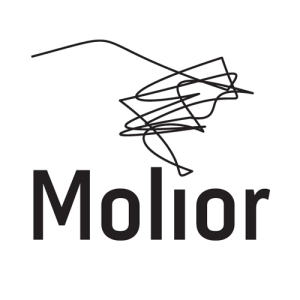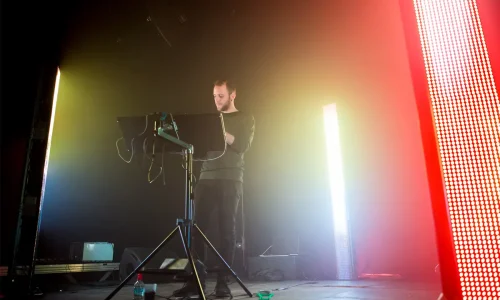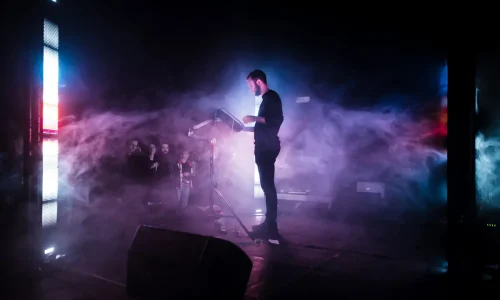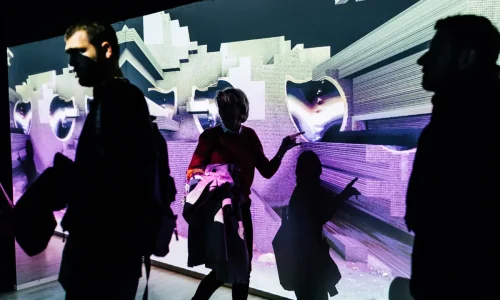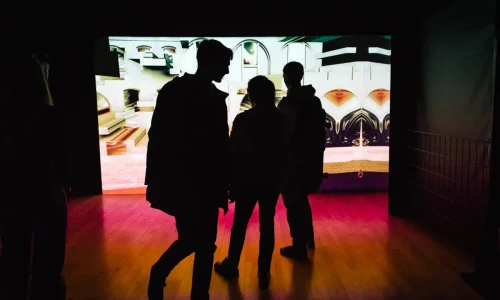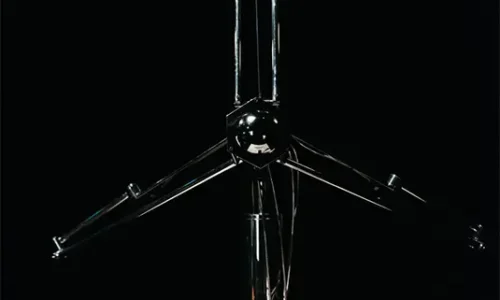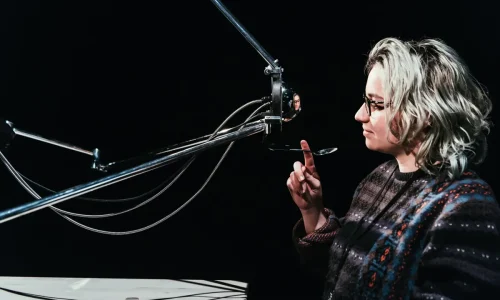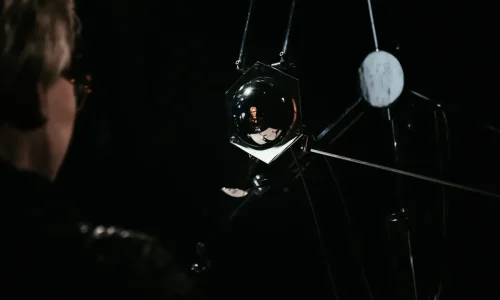Mirage Festival
Lyon, France
Du 4 au 8 avril 2018
Molior et Mirage Festival s’associent pour une première collaboration en présentant trois œuvres d’art numérique de quatre artistes du Québec.
Ils coproduisent une nouvelle œuvre de Sabrina Ratté, Machine for Living, présentée pour la première fois sous forme installative. Composée de cinq larges projections vidéo et de miroirs, l’œuvre se déploie en une véritable structure architecturale immersive formant un parcours labyrinthique. Molior et Mirage Festival exposent aussi l’installation robotique et interactive de Simon Laroche et David Szanto Orchestrer la perte / Perpetual Demotion et présentent la performance de Lucas Paris AntiVolume IN/EXT.
Cette année, Mirage Festival s’intéresse aux œuvres qui déploient de multiples dimensions spatiales et sollicitent des espaces sensoriels inusités chez le spectateur afin de lui faire expérimenter d’autres réalités. Ces œuvres suscitent l’engagement du public en lui proposant des expériences de l’ordre du fictif, de l’onirique ou du virtuel.
La sélection élaborée par Mirage Festival et Molior a pris en compte trois axes particuliers de la thématique pour traiter de l’expérimentation d’autres réalités : le premier axe renvoie à la relation des espaces et de l’architecture réels/virtuels/actuels ; le second, aux rapports humain/machine ; le troisième, à l’expérience d’environnement synesthésique.
Sabrina Ratté a réalisé ses vidéos pour Machine For Living lors de sa résidence au Château Éphémère à Carrières-sous-Poissy. Elle a créé des architectures en s’inspirant des grands ensembles des banlieues parisiennes et des villes nouvelles telles que Noisy-le-Grand, Créteil, la Grande Borne, la Défense et Cergy-Pontoise. Les vidéos s’animent à travers des textures, des couleurs et des formes dont l’esthétique rappelle les technologies d’autres époques, telles que les synthétiseurs vidéo, mixeurs et feedbacks visuels. « L’esthétique des villes nouvelles est transformée, manipulée et déconstruite pour renaître en environnements à la fois abstraits et reconnaissables, surréels mais évocateurs d’une certaine réalité connue. (1)» Les projections divisent et agencent l’espace d’exposition, forment des murs et un trajet au sein duquel le spectateur peut déambuler.
La dimension sonore créée par Roger Tellier Craig est composée de cinq trames, chacune dédiée à une vidéo et localisée. Elles forment un ensemble sonore dont l’écoute varie selon la position du spectateur.
Des miroirs fixés au bord de chaque écran répliquent les images, les prolongent. Le dédoublement par les miroirs et certaines itérations formelles dans les cinq vidéos produisent un effet de répétition similaire à celui des ensembles de logements collectifs et brouillent les limites de l’espace expérimenté.
La multiplicité des dimensions des espaces se retrouve au sein de l’image, par l’intermédiaire des architectures de référence et des éléments et textures reconnaissables qui semblent digitaux ou issus d’un enregistrement du réel. L’installation accentue cet effet dans les correspondances entre les multiples vidéos, et du fait des délimitations incertaines de l’espace actuel.
Orchestrer la perte / Perpetual Demotion, installation robotique, nourrit les humains qui se présentent face à elle. Son bras robotisé s’abaisse pour prendre une cuillère. Une pâte comestible y est déposée. Le bras se déplie et se dirige alors vers la bouche du spectateur. Ce dernier peut décider d’accepter la bouchée et l’ingérer. La machine remet ensuite la cuillère à son esclave, un humain assis auprès d’elle, qui l’assiste et la débarrasse du couvert utilisé.
L’installation requiert du spectateur qu’il s’engage physiquement et coordonne son corps au robot, et ainsi sollicite ses sens – visuel mais aussi proprioceptif, en plus du goût. L’expérience esthétique investit l’espace interne du corps du spectateur puisque celui-ci doit accepter de se faire nourrir, puis d’ingérer la pâte alimentaire.
L’œuvre joue sur la confiance que le spectateur est prêt à accorder d’une part à l’artiste et d’autre part à la machine, dans un contexte complexe qui a le pouvoir de le convaincre. Elle met en scène la prise en charge, par un dispositif automatisé et robotisé, intrusif, d’une action de notre quotidien, « se nourrir ». Par extension, on pense au développement et à l’implication des systèmes d’intelligence artificielle ou des robots dans nos sociétés, qui gèrent de plus en plus nos vies, de la dimension intime à celle sociétale. L’œuvre remet en perspective le rapport de dominant et de dominé entre l’humain et la machine dans « un contexte de détermination technologique orchestrant la perte de contrôle généralisée (2) ».
Ces relations de pouvoir se retrouvent donc à de multiples niveaux et sont multidirectionnelles, tant dans le rapport de la technologie aux êtres humains que dans le rapport aux microbes. Une partie des ingrédients fermentés est mélangée et mise en interaction avec d’autres pasteurisés. « L’œuvre offre un point de vue saisissant sur les aspects systémique et performatif de l’alimentation (3)» et traite des enjeux biologiques, économiques et socio-culturels de l’alimentation. Sa présentation dans la capitale de la gastronomie française revêt une dimension supplémentaire. Elle lance le débat sur la place de l’alimentation comme référence au territoire et à des comportements spécifiques. L’œuvre confronte le spectateur à sa propre représentation culturelle de l’alimentation, que ce soit par référence à son expérience, sa mémoire ou son émotion. Puisque notre nourriture nous définit – ce que nous mangeons définit ce que nous sommes ou ne sommes pas (4) –, elle place le public dans une situation de rencontre de l’autre et d’autres réalités.
Durant la performance AntiVolume IN/EXT, Lucas Paris élabore en temps réel une composition à la fois sonore et de lumière, en partie improvisée, qui tend à plonger le spectateur dans un état méditatif. Trois colonnes de diodes électroluminescentes sont placées sur scène et modulent l’espace selon leur variation lumineuse. L’artiste s’inspire directement des musiques électroniques telles que le noise, l’electronica et l’ambient. Il appréhende son projet comme une « sculpture volatile et énergétique (5)» qu’il fait évoluer en intensité entre des effets granulaires et des nappes englobantes. L’œuvre procure une expérience « physique et texturale (6)». Le spectateur est immergé et captivé par la performance dans une synesthésie sonore, visuelle mais aussi proprioceptive, c’est-à-dire dans une similitude et une traduction entre les afférences du son, de la lumière et de la sensation de son propre corps. L’ensemble de la performance transporte le public dans son environnement intangible alors que le son et la lumière pénètrent et circulent à travers tout le corps.
[Aurélie Besson]
MIRAGE FESTIVAL
Le Mirage Festival explore depuis six ans la diversité des cultures numériques. Il propose au grand public de découvrir leur pluralité et joue également un rôle de catalyseur pour tout un écosystème d’acteurs du secteur artistique, culturel et des industries créatives.
Première manifestation dédiée aux cultures numériques à Lyon, le Mirage Festival a su s’intégrer de manière pertinente dans le vaste paysage culturel et événementiel de la Métropole de Lyon en proposant une programmation pluridisciplinaire, ambitieuse, défricheuse et aventureuse, laissant entrevoir un aperçu de la création de demain.
Agissant sur les dimensions spatiales et parfois sensorielles du spectateur, mais surtout en sollicitant la force de son imaginaire, les œuvres présentées dans le cadre du parcours d’exposition invitent le public à « expérimenter d’autres réalités », qu’elles soient virtuelles, sensibles ou parallèles. En créant des dispositifs voués à être expérimentés, les artistes font appel à l’engagement physique du spectateur qui, placé dans un nouvel univers fictif, onirique, virtuel, voit son environnement modifié, ses sens sollicités. Cherchant à altérer notre relation au réel, ils font émerger de nouvelles réalités aux frontières indéfinies et aux contours indistincts. Il n’y a alors plus une seule et unique réalité, mais plusieurs réalités.
Ce projet a obtenu le soutien du Conseil des arts et des lettres du Québec. Molior tient également à remercier son partenaire Mirage festival, le Conseil des arts du Canada et le Conseil des arts de Montréal et la Délégation générale du Québec à Paris pour leur précieuse collaboration.
Artistes et oeuvres
Lucas Paris
Description de l'oeuvre
AntiVolume est une œuvre immersive qui nous plonge dans un environnement synesthésique de timbres sonores et lumineux. La présente version, intitulée IN/EXT, explore les mouvements et les dynamiques qui se produisent entre l’intérieur et l’extérieur.
Au cours de cette performance, le public se trouve en présence d’une sculpture volatile et énergétique, composée de son et de lumière. Résultant d’une exploration algorithmique, celle-ci est sculptée en temps réel par le travail d’improvisation de l’artiste. Trois colonnes de lumière occupent l’espace de la performance. Le public est immergé dans l’œuvre et la reçoit comme une expérience physique et texturale.
Ce travail est en constante évolution. En partie improvisée, chaque performance est unique et reflète le contexte (lieu et public) dans lequel elle est présentée. Lucas Paris puise son inspiration dans le vaste vocabulaire de la musique électronique : noise, ambient, IDM, EDM… Ces éléments référentiels sont réinterprétés par l’entremise d’une forte personnalité musicale et d’une fantasmagorie très personnelle.
Remerciements à Perte de Signal, Eastern Bloc, Maxime Damecour et Pipo Pierre-Louis.
Biographie
Artiste émergent dans le domaine des arts numériques et de la musique électronique, Paris crée depuis plus de dix ans des instruments numériques qui lui permettent de sculpter le son et la lumière de manière à produire en temps réel des œuvres intangibles.
Jumelant une approche artistique à la fois très expressive et réfléchie à l’utilisation de réseaux de synthèse numérique de haute technologie et à la conception d’instruments modulaires, Lucas Paris crée de nouvelles formes de performances audio-visuelles immersives, qui se caractérisent par leur qualité multi-sensorielle et émotionnelle.
Avec les groupes QUADr et BetaFeed ainsi qu’avec ses propres projets AntiVolume et Array, Paris a participé aux festivals MUTEK Montréal (2016-2017), MUTEK/ISEA Vancouver (2015) et Akousma (2016), ainsi qu’à la Biennale internationale d’art numérique de Montréal (2014 et 2016) et au Toronto International Electroacoustic Symposium (2015). Artiste en résidence au centre Eastern Bloc à Montréal en janvier 2015, et à la VYV Corporation en janvier 2018, Paris est présentement artiste en résidence à l’Institut Milieux de l’Université Concordia (depuis septembre 2017) et membre du centre d’artistes Perte de signal. Il a étudié la musique numérique et la lutherie audionumérique à l’Université de Montréal.
Sabrina Ratté
Description de l'oeuvre
Fruit d’un travail de recherche sur les grands ensembles architecturaux parisiens (Noisy-le-Grand, Créteil, la Grande Borne, la Défense, Cergy-Pontoise, etc.), l’installation immersive Machine for Living propose une visite virtuelle inspirée de ces villes nouvelles, autrefois symboles d’une certaine utopie aujourd’hui oubliée.
Le concept de standardisation des immeubles d’habitation est au cœur de cette œuvre à travers l’élément de répétition, chaque environnement créé représentant une variation sur le même modèle architectural. L’esthétique des villes nouvelles est transformée, manipulée et déconstruite pour renaître sous forme d’environnements à la fois abstraits et reconnaissables, surréels mais évocateurs d’une certaine réalité connue. Pour donner corps à cette nouvelle installation, Sabrina Ratté reste fidèle à ses médiums de prédilection en croisant différentes techniques telles que la photographie, la synthèse vidéo et l’animation 3D.
Bourse du Conseil des arts du Canada (Résidences internationales)
Projet réalisé dans le cadre d’une résidence au Château Éphémère, Carrière-sous-Poissy.
Une coproduction Mirage Festival et Molior.
Biographie
Sabrina Ratté vit et travaille entre Montréal et Paris. Après un baccalauréat et une maîtrise en production cinématographique à l’Université Concordia à Montréal, elle se concentre principalement sur la vidéo.
Son intérêt pour les débuts de l’art vidéo l’amène à travailler avec des technologies analogiques telles que la synthèse vidéo et les feedbacks visuels. Elle intègre ensuite l’animation 3D et plusieurs effets numériques à sa démarche, ce qui permet la création d’architectures plus complexes ainsi que d’une esthétique intemporelle. Ses œuvres se situent à mi-chemin entre l’abstraction et le figuratif, le paysage et l’architecture, et sur la fine ligne qui sépare le réel du virtuel.
Son travail inclut des installations, impressions et performances live. Expositions passées : Material Art Fair (Mexico), Dolby Gallery (San Francisco), Young Project Gallery (Los Angeles), Whitney Museum of American Art (New York), Variation Media Art Fair (Paris), Chronus Art Center (Shanghai), Paddles ON!, premier encan d’art numérique chez Phillips, HeK (Bâle), EMPAC (Troy), Museum of the Moving Image (New York), Festival international du film de Rotterdam, Biennale internationale d’art numérique de Montréal, Centre Phi (Montréal), Arsenal (Montréal), Lampo (Chicago), festival Berlin Atonal, Elektra, MUTEK (Montréal, Mexico, Barcelone).
Elle est représentée par la galerie Laffy Maffei à Paris et la galerie Ellephant à Montréal.
Simon Laroche & David Szanto
Description de l'oeuvre
Une machine nourrit ses humains. En cherchant à ce que ceux-ci ingèrent la matière préparée qu’elle a le devoir de leur donner, la machine sustente sa couvée. De par sa taille et le rapport qui s’instaure entre elle et son bénéficiaire, elle dépasse la simple servitude. Si on considère les agents machiniques et synthétiques capables de transformer et reconfigurer le monde, la culture et la matière, on peut penser qu’ils participent effectivement aux affaires humaines et animent la singularité. Inévitablement, on procède alors au déclassement des agents sensibles et à la naturalisation de l’artefact, en envisageant un contexte de détermination technologique orchestrant la perte de contrôle généralisée.
Interrogeant les relations d’influence et de dépendance qui lient l’humain et la technologie, Orchestrer la perte / Perpetual Demotion est une installation robotique interactive constituée d’un robot nourricier, de pâtes comestibles, d’un réfrigérateur et d’un « esclave ». En asservissant l’humain au robot, puis en incorporant des aliments fermentés et pasteurisés, l’œuvre offre un point de vue saisissant sur les aspects systémique et performatif de l’alimentation. Elle invite aussi à réfléchir sur les conséquences économiques, politiques et écologiques des activités humaines.
Biographie
Artiste, enseignant et concepteur en médias interactifs, Simon Laroche crée des installations et des performances audiovisuelles et body art. Il a développé une approche critique de l’hybridation des systèmes artificiels, biologiques et sociaux. Cofondateur du collectif Projet EVA, il crée des œuvres critiques, expérimentales et transgressives centrées sur les problématiques propres aux relations entre les individus, les systèmes informatiques et leurs extensions physiques. Simon Laroche enseigne les arts électroniques à l’Université Concordia et collabore avec des créateurs œuvrant dans les domaines du théâtre, de la danse, de la mode et du cinéma. Ses projets ont été présentés en Europe, en Asie, au Moyen-Orient et dans les Amériques.
David Szanto est chercheur, artiste et écrivain. Il a recours à une approche expérimentale en gastronomie à travers les domaines du design, de l’écologie et de la performance. Ses projets précédents comprennent The ‘Main’ Dish et A Tranche of Berlin, deux repas-performances qui représentaient des panoramas urbains alimentaires, Displace (Mediations of Sensation), un environnement sensoriel immersif, et The Gastronome in You, performance traitant de la continuité de la vie humaine à travers la mémoire, le levain et le microbiote. Il a enseigné en études alimentaires à l’Université Concordia et à l’Université du Québec à Montréal, ainsi que la gastronomie et les communications à l’Université des sciences gastronomiques d’Italie. David Szanto a écrit plusieurs articles et chapitres sur l’alimentation, l’art et la performance ; il est également chroniqueur pour la revue Montréal enSanté.
